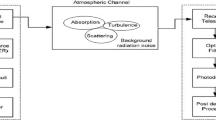Abstract
Free Space Optics (FSO) is an emerging line-of-sight technology intending to provide last-mile solution to the network problem where fiber technology is not feasible. The use of Wavelength Division Multiplexing (WDM) technology for FSO is inspired due to the demand for broadband communication. This technique has brought a revolution because the system data capacity is enhanced by simply adding more number of channels and reducing the channel spacing without having the need of more than one FSO link. By reducing the channel spacing to an appropriate level, Dense Wavelength Division Multiplexing (DWDM) based FSO systems are also be attained and are reported by various research works. FSO finds applications in vast areas like backhaul networks for cellular communication, disaster recovery, LAN–LAN connectivity, high-definition TV, MAN-extension, video transmission, medicine industry and surveillance. However, its usage is limited due to the serious challenges of link vulnerability to weather and atmospheric turbulence-induced fading. This paper is based on a WDM-FSO system. An 8-channel WDM based FSO system is proposed and performance is evaluated on widely accepted modulation schemes under weak, moderate and strong turbulence conditions. Gamma–Gamma fading model is employed for atmospheric turbulence modelling. The system is simulated on OptiSystem 14.0.





Similar content being viewed by others
References
Al-Habash, M.A., Andrew, L.C.: Mathematical model for the irradiance probability density function of a laser beam propagating through turbulent media. Opt. Eng. 40(8), 1554–1562 (2001)
Andrews, L.C., Phillips, R.L.: Laser Beam Propagation Through Random Media, 2nd edn. SPIE Press, Bellingham WA (2005)
Becker, P.C., Olsson, N.A., Simpson, J.R.: Erbium-Doped Fiber Amplifiers: Fundamentals and Technology. Academic Press, San Diego (1999)
Dar, A.B., Jha, R.K.: Chromatic dispersion compensation techniques and characterization of fiber Bragg grating for dispersion compensation. Opt. Quant. Electron. 49(108), 1–35 (2017)
David, F.: Scintillation loss in free-space optic im/dd systems. In: LASE 2004, vol. 5338, San Jose, USA. (2004)
Fadhil, H.A., et al.: Optimization of free space optics parameters: an optimum solution for bad weather conditions. Optik Int J. Light Electron Opt. 124(19), 3969–3973 (2013)
Gappmair, W., Flohberger, M.: Error performance of coded FSO links in turbulent atmosphere modeled by Gamma- Gamma distribution. IEEE Trans. Wireless Commun. 8(5), 2209–2213 (2009)
Gnauck, A.H., Winzer, P.J.: Optical phase-shift-keyed transmission. J. Lightwave Technol. 23, 115–130 (2005)
Gupta, A., et al.: A survey of free space optical communication network channel over optical fiber cable communication. Int. J. Comput. Appl. 105(10), 32–36 (2014)
Juarez, J.C., et al.: 40-Gbps modem architecture for free-space optical communications. In: MILCOM 2011 Military Communications Conference, pp. 578–582 (2011)
Khalighi, M.A., Uysal, M.: Survey on Free Space Optical Communication: a Communication Theory Perspective. IEEE Commun. Surv. Tutor. 16(4), 2231–2258 (2014)
Kim, I.I., et al.: Comparison of laser beam propagation at 785 nm and 1550 nm in fog and haze for optical wireless communications. Proc. SPIE 4214, 26–37 (2001)
Letzepis, N., Holland, I., Cowley, W.: The Gaussian free space optical MIMO channel with Q-ary pulse position modulation. IEEE Trans. Wireless Commun. 7(5), 1744–1753 (2008)
Liu, X.: Free-space optics optimization models for building sway and atmospheric interference using variable Wavelength. IEEE Trans. Commun. 57(2), 492–498 (2009)
Parry, G., Pusey, P.N.: BK distribution in atmospheric propagation of laser light. J. Opt. Soc. Am. 69(5), 796–798 (1979)
Phillips, R.L., Andrews, L.C.: Measured statistics of laser-light scattering in atmospheric turbulence. J. Opt. Soc. Am. 71(12), 1440–1445 (1981)
Popoola, W.O., Ghassemlooy, Z.: BBPSK subcarrier intensity modulated free-space optical communications in atmospheric turbulence. J. Lightwave Technol. 27(8), 967–973 (2009)
Thakur, R., et al.: Review on free space optics. Int. J. Comput. Technol. 8(1), 734–742 (2013)
Xie, G., et al.: Effects of atmosphere dominated phase fluctuation and intensity scintillation to DPSK system. In: IEEE International Conference on Communication (ICC), pp. 1–6 (2011)
Author information
Authors and Affiliations
Corresponding author
Rights and permissions
About this article
Cite this article
Badar, N., Jha, R.K. Performance comparison of various modulation schemes over free space optical (FSO) link employing Gamma–Gamma fading model. Opt Quant Electron 49, 192 (2017). https://doi.org/10.1007/s11082-017-1025-4
Received:
Accepted:
Published:
DOI: https://doi.org/10.1007/s11082-017-1025-4




